Every autumn, a narrow passage in the Pyrenees range between southern France and northeastern Spain is flooded by a torrential flood of marmalade hoverflies, pollinators with citrus-colored bodies and black stripes. Hoverflies avoid harsh mountain headwinds by flying close to the ground, making sunny snow showers appear “almost like a river of golden light,” said Will Hawkes, an insect migration scientist at the Ornithological Institute Swiss. Flotillas of white and yellow butterflies hovering above the flies are more easily buffeted by the winds, swirling by the thousands across the pass. “It’s almost like a snowstorm, with all the whites and yellows,” Hawkes said.
Marmalade hoverflies, butterflies and countless other insects all migrate south for the winter, some stopping in the warmer climes of Spain and others potentially heading to sub-Saharan Africa. Bujaruelo Pass, which sits at nearly 7,500 feet above sea level and is just under 100 feet wide, offers the insects a more hospitable gateway to Spain than the surrounding peaks. But it is not a resting place, devoid of plants on which flies could feed and where it is very cold at night. So on the busiest migration days, buzzing hoverflies produce a buzz – not the nonchalant buzz of a wandering bee in a garden, but a sustained note. “They have to pass, so it’s a really determined buzz,” Hawkes said.
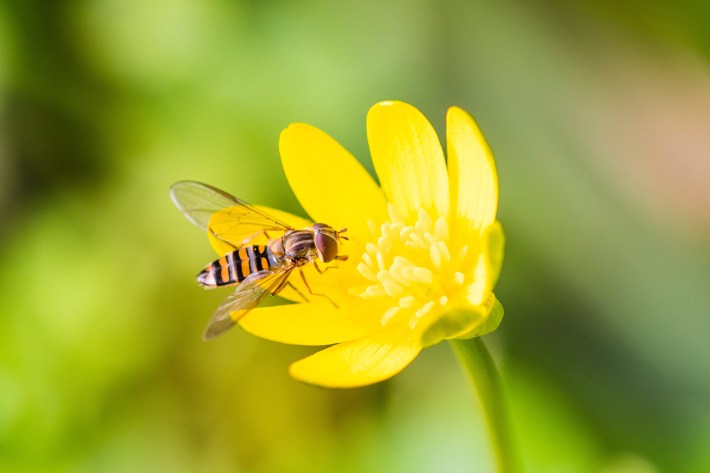
This spectacular insect migration was first recorded in 1950 by married ornithologists David and Elizabeth Lack, who came to the pass on a honeymoon of sorts to observe how small birds crossed the rugged peaks of the Pyrenees, which can rise to 11,000 feet. Although few researchers visited the pass in subsequent years, nearly 70 years passed without a published study on the migration. In 2018, a group of researchers, including Hawkes, decided to change that. Their investigation into four years of autumn migrations was published Wednesday in the journal Proceedings of the Royal Society B.
Hawkes had become fascinated with migratory insects when he was investigating one such migration across the Alps as a student. When his dissertation advisor Karl Wotton, another author of the paper, told him about Lacks’ paper in 2018, Hawkes jumped at the chance to do field work that fall. The researchers wanted to do a systemic analysis of the migration to find out how many and what types of insects were involved. For large, slow-moving butterflies, counting was quite simple. Every two hours during the day, Hawkes would sit on a rock on one side of the pass and count how many butterflies flew past him in 15 minutes: a rush of white, cabbage-shaped butterflies. Pieris outsideand darkened yellow butterflies Crocus Colias.
But it was impossible to count the vast majority of migratory insects by sight alone. They arrived as gliding deluges, some measuring only millimeters long. On some days, researchers observed more than 3,000 flies per meter per minute. To count these insects, which all flew close to the ground to avoid headwinds, the researchers placed a smartphone camera in a waterproof case and placed it facing a rock. All day long, the phone was recording one-minute videos every 15 minutes.
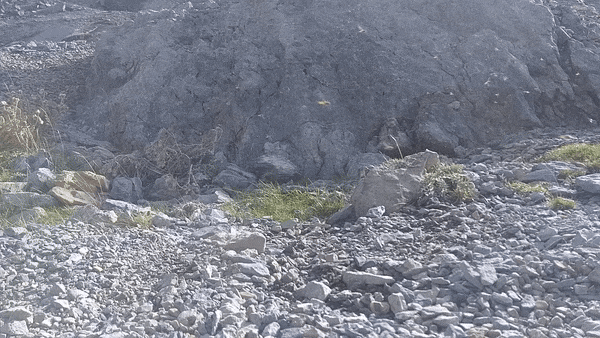
Although data collection was easy, data extraction was a hassle. Researchers tried to design computer software or an AI model to detect insects in the background, but nothing worked, Hawkes said. “In the end, it was the quickest thing for me to sit for about a month and count the number of flies individually as they moved through the frame,” he said. “It was millions of flies.” But even these images held some fun surprises, functioning as a camera trap to capture the various creatures inadvertently captured by the camera: wandering stoats, curious birds and the occasional tourist peeing near the rock.
Because the video footage wasn’t clear enough for the researchers to actually identify the flies scurrying by, they set up a fixed net trap on the side of the pass. Migratory insects flew into the net, got stuck, crawled toward an opening, and fell into a bottle of ethanol. It was the only way scientists could collect a representative sample of their tiny specimens, which Hawkes would identify at night. “We recorded every type of insect migrating through this mountain pass, which has never been done before,” he said.
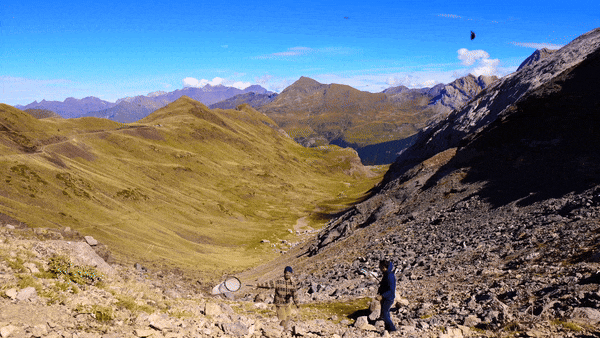
To estimate the number of insects moving through the passage, the researchers were able to discern the ratio of insect groups caught in the traps. If 20 percent of the insects in the trap were hoverflies, they assumed that 20 percent of the insects filmed were hoverflies. Overall, researchers estimate that 17.1 million insects cross the Bujaruelo Pass each year, suggesting that billions of insects likely cross the Pyrenees mountain range each year.
Sometimes, during the researchers’ visits, the Bujaruelo pass seemed empty. The air seemed clear, free of any tiny migrants. Yet when Hawkes swung his net over the edge of the pass, where the insects would rise, it filled with tiny flies. And as the hoverflies disappeared after sunset, they were replaced by squeaky death’s-head hawkmoths that beat their wings down the corridor, perfumed with the scent of the honey they had stolen from the hives. Observing this relentless and determined journey of millions of insects always makes Hawkes humble. “You feel like you’re observing something much bigger and more important than you,” he said.
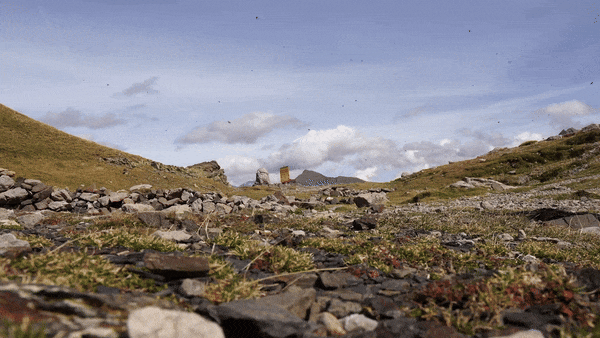
The researchers only included groups of insects in their analysis if they were seen more than 100 times. Insects that did not make the cut included bumblebees, painted butterflies and hummingbird hawkmoths. At night, researchers also observed turnip moths followed by their enemies, tiny parasitic wasps known to lay their eggs in turnip moth caterpillars. Hawkes thinks these sparser animals must still be migrants. “Why else would they be up there?” he said.
Before Hawkes visited the pass in person, he expected butterflies and dragonflies to be the most abundant travelers, in part because Lacks’ journal estimated that hundreds of butterflies crossed the pass every hour, accompanied of a dizzying flow of dragonflies. These showy insects also “steal their famous insect migration headlines,” Hawkes joked. But they represented only 2 percent of the migration. But it was clearly the flies that stood out, which made up 90 percent of all registered aviators. “That’s what was most exciting for me, because it just opens up this other world,” Hawkes said.
Most research on pollinators focuses on bees, relegating other insect pollinators to the patronizing group of “non-bee pollinators.” But hoverflies are extremely abundant pollinators known to visit at least 72 percent of the world’s food crops, according to a 2020 paper. Adults feed on nectar and pollen, which they can carry very long distances during migration , or even more than 62 miles in open water. Marmalade hoverflies hatch in late summer and begin flying south when temperatures drop, flying with the winds and using the sun as a compass, Hawkes said. About 75 percent of migratory marmalades are female, often carrying their sperm to their final destination to lay their eggs, which will grow to return to the hoverflies’ northern home over a series of generations. Together, these generations of humble hoverflies carry nutrients, pollen and elements across the world. “If we didn’t really think that flies migrate, then we missed the whole ecological impact of them on the planet,” Hawkes said.
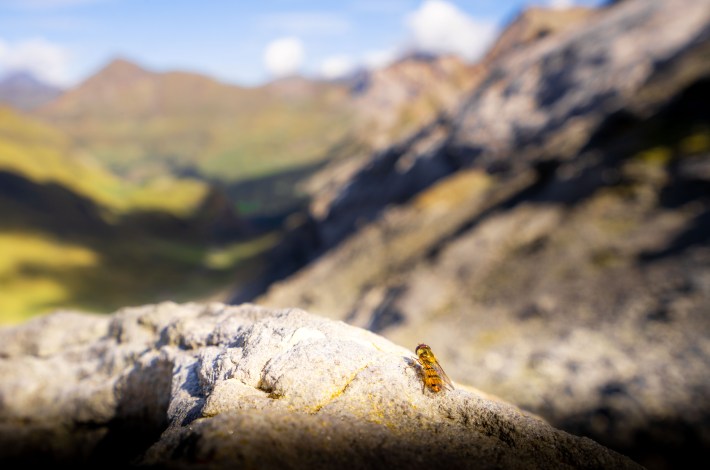
Although the researchers could not directly compare the number of insects in the pass to the historical numbers recorded more superficially by the Lacks, a study in the mountains of southwestern Germany found that populations of migratory aphid-eating hoverflies had fallen 97 percent since 1970. “We can presume there will be a similar decline” in the Pyrenees, Hawkes said, adding that habitat loss, pesticide use and Climate change threatens all populations of hoverflies and other insects.
This outlook is far from ideal. But Hawkes hopes people will take an interest in these surprising and remarkable migrants and make the world more welcoming to their journey, by planting wildflowers or lobbying local governments to protect the species. He pointed out that insects like marmalade hoverflies can lay thousands of eggs and reproduce all year round. “They could, if they have the opportunity, if we provide them with habitat, have a lot of children and then their numbers could increase again very quickly,” he said. “They’re very resilient. We just have to give them the chance to do it.”